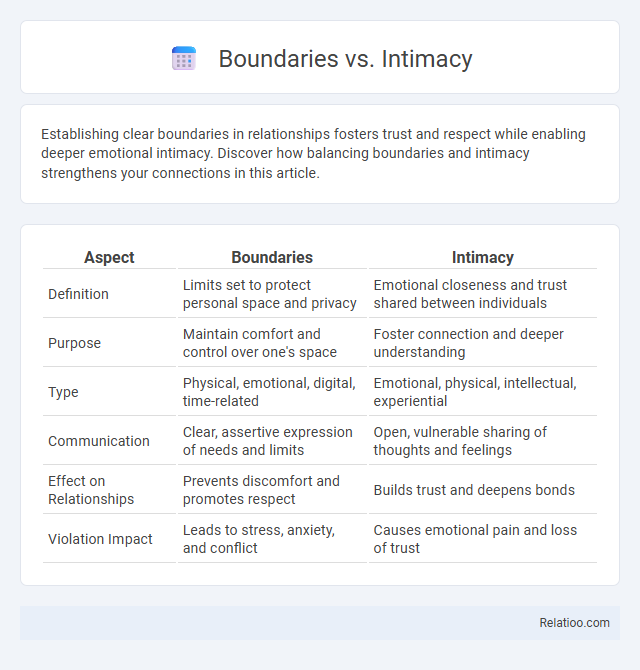Establishing clear boundaries in relationships fosters trust and respect while enabling deeper emotional intimacy. Discover how balancing boundaries and intimacy strengthens your connections in this article.
Table of Comparison
| Aspect | Boundaries | Intimacy |
|---|---|---|
| Definition | Limits set to protect personal space and privacy | Emotional closeness and trust shared between individuals |
| Purpose | Maintain comfort and control over one's space | Foster connection and deeper understanding |
| Type | Physical, emotional, digital, time-related | Emotional, physical, intellectual, experiential |
| Communication | Clear, assertive expression of needs and limits | Open, vulnerable sharing of thoughts and feelings |
| Effect on Relationships | Prevents discomfort and promotes respect | Builds trust and deepens bonds |
| Violation Impact | Leads to stress, anxiety, and conflict | Causes emotional pain and loss of trust |
Understanding Boundaries and Intimacy
Understanding boundaries and intimacy is crucial in navigating the dynamics between personal space and closeness in a partnership. Clear boundaries protect your emotional well-being and define comfort zones, while healthy intimacy fosters trust and deep connection without compromising individuality. Balancing these elements strengthens the partnership by ensuring respect and mutual understanding coexist with emotional closeness.
The Importance of Setting Healthy Boundaries
Establishing healthy boundaries is essential for maintaining intimacy and partnership by ensuring mutual respect and clear communication. Healthy boundaries prevent emotional burnout and foster trust, allowing partners to feel safe and valued. Consistent boundary-setting supports balanced interdependence, strengthening the foundation of a sustainable relationship.
How Boundaries Affect Emotional Intimacy
Clear boundaries establish a safe space where emotional intimacy can thrive by ensuring both partners feel respected and understood. When boundaries are honored, Your trust deepens, allowing vulnerability without fear of judgment or intrusion. Conversely, blurred boundaries can hinder emotional closeness, leading to misunderstandings and emotional distance within the partnership.
Types of Boundaries in Relationships
Types of boundaries in relationships include physical, emotional, intellectual, and time boundaries, each crucial for maintaining healthy intimacy and partnership dynamics. Physical boundaries protect personal space and touch preferences, while emotional boundaries safeguard feelings and vulnerability levels. Your awareness and respect for these boundaries foster trust and balance, promoting a strong, evolving partnership.
Signs of Unhealthy Boundaries
Unhealthy boundaries in relationships manifest through constant over-dependence, lack of personal space, and frequent emotional manipulation, which blur the lines between intimacy and autonomy. Signs include excessive jealousy, controlling behaviors, and an inability to say no or enforce limits, leading to a loss of individual identity within the partnership. These dynamics hinder trust and equality, creating a cycle of conflict and emotional exhaustion.
Building Trust Through Clear Boundaries
Clear boundaries establish a foundation of respect and safety, essential for building trust in intimacy and partnership dynamics. You create a space where vulnerability is welcomed without fear of overstepping personal limits, fostering deeper emotional connections. Setting and communicating these boundaries consistently strengthens mutual understanding and supports a balanced, healthy relationship.
Navigating Intimacy in Long-Term Relationships
Navigating intimacy in long-term relationships requires balancing healthy boundaries with deep emotional connection to maintain trust and respect. Your ability to communicate needs clearly while honoring your partner's space fosters growth and partnership stability. Understanding this dynamic enhances relationship satisfaction by creating a safe environment for vulnerability and mutual support.
Communication Strategies for Balancing Boundaries and Intimacy
Effective communication strategies for balancing boundaries and intimacy involve clear expression of personal needs while respecting the partner's limits. Utilizing active listening and assertive dialogue helps partners negotiate space and closeness without triggering misunderstandings or resentment. Establishing regular check-ins fosters trust and ensures both boundaries and intimacy evolve in harmony within the partnership.
Overcoming Boundary Issues Together
Overcoming boundary issues together strengthens the balance between personal limits and emotional closeness within your partnership. Open communication fosters mutual respect, allowing both partners to express needs without fear of judgment or rejection. Establishing clear boundaries while nurturing intimacy creates a trust-filled dynamic that supports growth and deep connection.
Cultivating Deeper Intimacy While Respecting Limits
Cultivating deeper intimacy involves balancing emotional vulnerability with clearly defined personal boundaries to maintain trust and mutual respect in a partnership. Effective communication about needs, desires, and limits fosters a safe environment where both partners can explore connection without fear of overstepping. Prioritizing consent and empathy strengthens relational dynamics, ensuring intimacy grows within agreed-upon boundaries.

Infographic: Boundaries vs Intimacy
 relatioo.com
relatioo.com